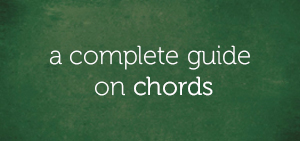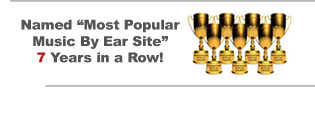If you’re interested in learning about extended chords, then you arrived at the right page.
Extended chords are sophisticated, and harmonically advanced chords that are mostly played by intermediate and advanced players.
We’re dedicating this lesson to the study of extended chords, with emphasis on what extended chords really are.
A Short Note On Chord Classification According To Width
A chord according to Jermaine Griggs is “a collection of three or more related notes (agreeable or not), which may be played or heard together”
Although there are many ways a chord can be classified, one of the ways chords can be classified is according to their width.
Attention: The width of a chord is determined by the number of notes it encompasses.
There are three classes of chords in the classification according to width:
Triads
Seventh Chords
Extended Chords
Triads encompass a fifth interval when played in root position. The C major triad:
…encompasses C to G:
…a fifth interval.
Seventh chords encompass a seventh interval when played in root position. The C major seventh chord:
…encompasses C to B:
…a seventh interval.
Chords that are bigger than seventh chords in width are classified as extended chords and are our focus in this lesson and subsequent segments are dedicated to studying them.
Extended Chords – Defined
Extended chords are chords that exceed the compass of an octave. The are referred to as extended chords because they are basically seventh chords with other chord tones known as extension.
Extensions are chord tones that are more than an octave above the root of the chord.
For example, the C major seventh chord:
…is formed in third intervals. C to E:
…E to G:
…and G to B:
…are all third intervals.
Adding D:
…to the C major seventh chord:
…produces an extended chord:
…because D is an extension.
“Why Is D An Extension…?”
D:
…is an extension in the C major ninth chord:
…because from C (which is the root of the chord) to D:
…is a ninth interval and exceed the compass of an octave.
So, the C major ninth:
…is an extended chord because it exceeds the compass of an octave.
Features Of Extended Chords
There are features of extended chords that you must take note of
1. Extended chords exceed the compass of an octave. This explains why its difficult to play certain extended chords with one hand.
2. Extended chords have names bigger than an eighth. The terms ninth, eleventh, and thirteenth are commonly associated with extended chords and are bigger than an eighth.
3. Extended chords cannot be inverted. Invertible chords are chords that are within the compass of an octave.
In a nutshell, any chord that has any of these features is an extended chord.
Extended Chord Types
Although there are many extended chords, they can be classified into three:
Ninth chords
Eleventh chords
Thirteenth chords
Let’s take a closer look at these three extended chord types.
Ninth Chords
Ninth chords are extended chords that encompass nine scale degrees. Due to the fact that ninth chords are formed in thirds, ninth chords usually have five chord tones.
The first, third, fifth, and seventh tones of a ninth chord are basically a seventh chord and for the most part, influence the ninth chord formed.
There are three ninth chord types that are commonly played/heard:
The major ninth
The minor ninth
The dominant ninth
Although there are are other ninth chord qualities, it is important to learn and master these ninth chord qualities in all twelve keys on the keyboard.
“Here Are Ninth Chords On C…”
C major ninth chord:
C minor ninth chord:
C dominant ninth chord:
Eleventh Chord
Eleventh chords are bigger than ninth chords, encompassing eleven scale degrees and consisting of six chord tones.
The first, third, fifth, and seventh tones of an eleventh chord are basically a seventh chord and for the most part, influence the eleventh chord formed.
The minor eleventh chord is the commonly played/heard eleventh chord and this is because the eleventh tone forms a minor ninth interval with the third tone in most ninth chord qualities. In the C major eleventh chord:
…the interval between the third tone (which is E):
…and the eleventh tone (which is F):
…is a minor ninth interval (E-F):
…and the minor ninth interval is one of the most dissonant intervals in harmony.
“Here’s The C Minor Eleventh Chord…”
C minor eleventh:
Thirteenth Chords
The most advanced chords in tonal music are thirteenth chord. A thirteenth chord consists of all the notes in the scale. For example, the C major thirteenth chord:
…consists of all the notes in the C major scale:
C is the root
D is the ninth
E is the third
F is the eleventh
G is the fifth
A is the thirteenth
B is the seventh
However, the eleventh tone is usually omitted or substituted with a raised eleventh (aka – “the sharp eleventh tone”.) The C major thirteenth chord:
…is usually played with the eleventh (which is F):
…omitted:
Thirteenth chords consist of all the tones of the scale, consequently, they are absolutely advanced.
Final Words
Now you’ve learned what extended chords are, we’ll stop here for today until the next time I’ll be coming your way again with another exciting lesson on the formation and application of extended chords.
See you then!
Chuku Onyemachi
Latest posts by Chuku Onyemachi (see all)
- The Formation Of Diminished Seventh Chords Used To Be Challenging Until I Did This
- How To Form Seventh Chords In Two Shakes Of A Dog’s Tail Using Third Intervals And The Circle Of Fifths Chart
- I Played The 13sus4 Chord And This Happened…
- How To Build Seventh Chords Like An Architect Using “Foundation And Structure” Concept
- This 4-Week Plan Will Help You Master All The Major Scales







Comments on this entry are closed.